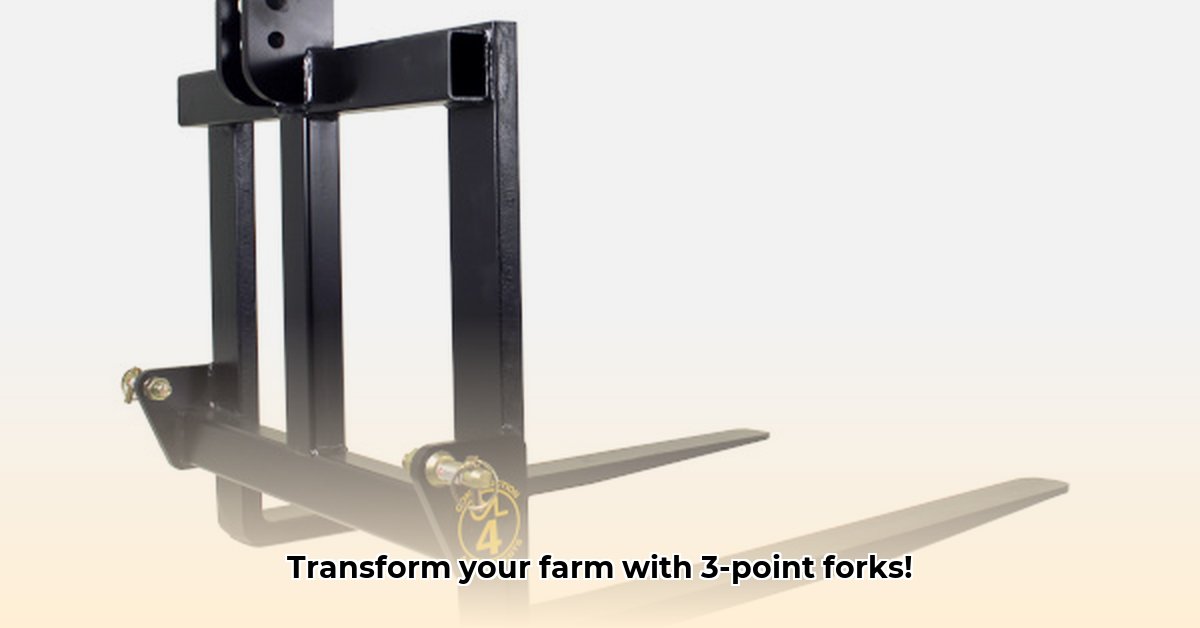
Choosing the Right 3-Point Tractor Forks
Selecting the optimal 3-point tractor forks involves careful consideration of several key factors to ensure both efficiency and longevity. Ignoring these factors can lead to costly repairs, reduced productivity, and even safety hazards. Let's delve into the process of choosing the perfect forks for your specific farming operations. For more information on small tractor attachments, check out this helpful resource: Small Tractor Attachments.
Tractor Compatibility: A Foundation of Safety and Efficiency
Before purchasing any 3-point attachment, consult your tractor's owner's manual. This crucial step ensures compatibility with your tractor's lift capacity and hydraulic system. Using forks exceeding your tractor's capabilities is extremely dangerous and can lead to significant equipment damage. For example, attempting to lift a heavy pallet with a tractor lacking sufficient power is akin to trying to lift a boulder with a shovel — it simply won't work, and you risk damaging your equipment. Always match the fork's weight capacity to your tractor’s limitations to maintain safe and efficient operation.
Matching Forks to Your Farming Tasks: Specialization for Success
Different tasks require different tools. Pallet forks are ideal for moving palettes of feed or supplies, while bale forks excel at handling hay bales. Consider your primary farming operations. If hay baling dominates your workload, bale forks are your best choice. Conversely, if you frequently move pallets of feed or supplies, pallet forks are the more efficient solution. Matching the fork to the specific task ensures optimal productivity and minimizes wasted effort. "Investing in the right tool is an investment in efficiency," says Dr. Amelia Hernandez, Agricultural Engineering Professor at the University of California, Davis.
Durability and ROI: The Long-Term Perspective
While the initial cost might seem higher for durable forks, the long-term return on investment (ROI) is significantly better. High-quality forks made from robust materials necessitate fewer repairs and replacements, reducing downtime and saving you money in the long run. Think of it this way: a cheap pair of work boots might seem economical initially, but they'll wear out quickly, necessitating frequent replacements. High-quality forks are analogous to investing in durable work boots; the initial investment pays off over time through increased longevity and reduced repair costs. "The higher upfront cost often translates to substantial long-term savings," explains John Miller, owner of Miller's Farm Equipment.
Optimizing 3-Point Fork Usage: Techniques for Efficiency
Efficient operation of your 3-point forks translates directly to savings in time, fuel, and money. Adopting these techniques will significantly improve your overall farming productivity.
Plan Your Moves: Strategically plan your movements to minimize unnecessary travel and lifting. Visualizing the process before you begin can significantly reduce wasted effort and fuel consumption.
Master Proper Lifting Techniques: Proper lifting and maneuvering techniques are crucial for both safety and equipment longevity. Improper lifting can result in damage to your forks, tractor, or even injury to the operator. Consult your tractor's manual and any available training resources to perfect these techniques.
Maintain a Steady Pace: Avoiding rushed movements prevents accidents and ensures efficient operation. A steady, controlled pace is safer and more productive.
Maintaining Your Forks: The Key to Longevity
Regular maintenance is crucial for maximizing the lifespan of your 3-point forks and preventing costly repairs.
Regular Inspections: After each use, thoroughly inspect your forks for any signs of wear and tear, such as bent tines, loose bolts, or other damage. Addressing minor issues promptly prevents them from escalating into major problems.
Lubrication: Regularly lubricate all moving parts to ensure smooth operation and prevent premature wear. Consistent lubrication is a simple preventative measure with significant long-term positive effects.
Prompt Problem Resolution: Don't ignore small issues. Address them immediately to prevent them from becoming more serious and expensive repairs.
Sustainability and the Future of 3-Point Tractor Forks
While the direct environmental impact may appear relatively minor, the efficiency gains from using 3-point forks contribute significantly to sustainable agriculture.
Eco-Friendly Options: Seek out manufacturers utilizing recycled materials or employing sustainable manufacturing practices.
Repairable Designs: Prioritize forks with easily repairable designs, minimizing waste and extending their lifespan.
Alternative Fuels: Consider using renewable energy sources to power your tractor, complementing the efficiency gains from your 3-point forks.